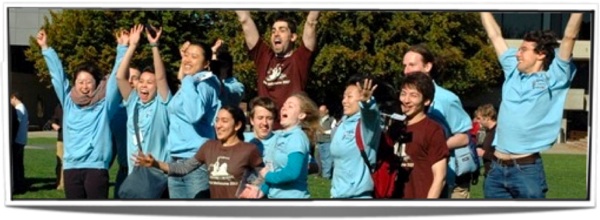Start A Team
From 2009.igem.org
| (3 intermediate revisions not shown) | |||
| Line 2: | Line 2: | ||
[[Image:Start_a_team.jpg]] | [[Image:Start_a_team.jpg]] | ||
We're glad you're excited about starting an iGEM team! This section of the site is dedicated to helping you learn how teams work and helping you get started. If you would like to learn more about iGEM in general, check out the '''[[About | What is iGEM]]''' page. | We're glad you're excited about starting an iGEM team! This section of the site is dedicated to helping you learn how teams work and helping you get started. If you would like to learn more about iGEM in general, check out the '''[[About | What is iGEM]]''' page. | ||
| - | |||
'''Note''': iGEM teams '''must''' be composed of at least two instructors and a number (usually between 6-12) of [[Start_A_Team/Team_Anatomy#Students|"undergraduate" students]]. One of the keys to a successful iGEM is getting a group of interested students together with interested faculty advisors as early as possible. So if you are a student, one of your first goals should be finding potential advisors. Likewise, if you are an educator, the first step to forming the team is to get the word out with info sessions, posters, publicity, etc. | '''Note''': iGEM teams '''must''' be composed of at least two instructors and a number (usually between 6-12) of [[Start_A_Team/Team_Anatomy#Students|"undergraduate" students]]. One of the keys to a successful iGEM is getting a group of interested students together with interested faculty advisors as early as possible. So if you are a student, one of your first goals should be finding potential advisors. Likewise, if you are an educator, the first step to forming the team is to get the word out with info sessions, posters, publicity, etc. | ||
| Line 8: | Line 7: | ||
Keep this in mind as you read through the following documentation. | Keep this in mind as you read through the following documentation. | ||
| + | Also, please consider how to develop an iGEM Team for your University that is not sensitive to any one person graduating or moving. Taking advantage of support and funding mechanisms available to undergraduate student organizations can be a great way to develop a new (or strengthen an existing) iGEM Team that is competitive for years to come! | ||
[[Start A Team/Team Anatomy|Anatomy of an iGEM Team]] | [[Start A Team/Team Anatomy|Anatomy of an iGEM Team]] | ||
| + | |||
| + | [[Funding]] | ||
[[Start A Team/What Happens During iGEM|What Happens During iGEM]] | [[Start A Team/What Happens During iGEM|What Happens During iGEM]] | ||
| - | + | [[Synthetic Biology Reading]] | |
| - | + | ||
| - | [[Synthetic Biology]] | + | |
[[Jamboree]] | [[Jamboree]] | ||
</div> | </div> | ||
Latest revision as of 15:36, 21 March 2009
 We're glad you're excited about starting an iGEM team! This section of the site is dedicated to helping you learn how teams work and helping you get started. If you would like to learn more about iGEM in general, check out the What is iGEM page.
We're glad you're excited about starting an iGEM team! This section of the site is dedicated to helping you learn how teams work and helping you get started. If you would like to learn more about iGEM in general, check out the What is iGEM page.
Note: iGEM teams must be composed of at least two instructors and a number (usually between 6-12) of "undergraduate" students. One of the keys to a successful iGEM is getting a group of interested students together with interested faculty advisors as early as possible. So if you are a student, one of your first goals should be finding potential advisors. Likewise, if you are an educator, the first step to forming the team is to get the word out with info sessions, posters, publicity, etc.
Keep this in mind as you read through the following documentation.
Also, please consider how to develop an iGEM Team for your University that is not sensitive to any one person graduating or moving. Taking advantage of support and funding mechanisms available to undergraduate student organizations can be a great way to develop a new (or strengthen an existing) iGEM Team that is competitive for years to come!
 "
"